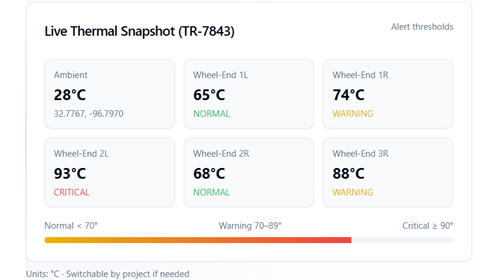
/
September 13, 2024
/
#
Min Read
Understanding CARB Reporting to Get Financial Support from HVIP
The California Air Resources Board (CARB) plays a critical role in setting and enforcing emissions standards to enhance air quality across California. As part of its efforts, CARB oversees various programs, including the Hybrid and Zero-Emission Truck and Bus Voucher Incentive Project (HVIP). HVIP provides substantial financial incentives to companies that adopt cleaner, zero-emission vehicle technologies. These incentives are designed to offset the higher initial costs associated with zero-emission vehicles, making it economically feasible for businesses to transition to greener and more sustainable fleets. In this blog, we will delve into the steps required not only to achieve compliance but also to accelerate and automate the filing process to get your money sooner, as well as how Sibros can simplify and automate the entire CARB reporting process.
Data Logging Requirements for CARB Reporting
Accurate and comprehensive data logging is crucial for CARB reporting. Companies need to log data on vehicle operations, focusing on metrics like operating hours, mileage, and locations relative to disadvantaged communities (DACs), where air quality improvements are most needed. This data must be collected continuously and reported quarterly, with each report including both current and cumulative data over three years. The quality and depth of the data are paramount, requiring high-resolution time stamping, selective logging based on events, and advanced data filtering to ensure only relevant information is captured and transmitted.
Why DACs
While improving air quality is a significant goal, it is not the only motivation for focusing on Disadvantaged Communities. Other motivations include promoting environmental justice by addressing the disproportionate burden of pollution these communities face, improving public health outcomes, and fostering economic benefits through job creation and reduced healthcare costs. Additionally, enhancing environmental quality in DACs can boost community resilience to environmental and economic challenges. Initiatives like HVIP help fulfill legal and regulatory mandates aimed at reducing disparities and creating equitable, healthy, and sustainable communities.
HVIP Incentive Amounts and Eligibility
HVIP financial incentives run between $20,000 and $240,000 USD, however, the actual voucher amount may vary depending on the vehicle category. Typically amounts are as follows:
- Shuttle Buses: $30,000 - $85,000
- School Buses: $43,000 - $120,000
- Straight Trucks: $30,000 - $120,000
Incentives can be stacked with other incentives or adjusted based on voucher modifiers such as fleet size, vehicle weight class, type of use, location of use, emission category/fuel type, and energy storage capacity.
To qualify for HVIP, vehicles must be new, have a minimum warranty period, and meet specific emission standards.
- New Zero-Emission Vehicles: Must have a minimum 35-mile all-electric range.
- Zero-Emission Vehicle Conversions: Conversion kits must be CARB-approved.
- New Plug-In Hybrid Vehicles: Must demonstrate at least a 35% improvement in fuel economy and a 35-mile all-electric range.
- Vehicles with ePTO: Specific requirements for battery capacity and system functionality.
- Low NOx Standard Vehicles: New or repowered vehicles using engines certified to the optional Low NOx standard of 0.01 g/bhp-hr.
Vehicles must also be purchased from a participating dealer.
Steps to Qualify for HVIP Financial Incentives
To qualify for HVIP financial incentives, companies must adhere to a set of rigorous requirements outlined by CARB. These steps ensure that vehicles not only meet the necessary environmental standards but also operate efficiently within DACs.
Automakers must first equip their vehicles with a robust data acquisition system capable of collecting and transmitting detailed GPS data and mileage information, including but not limited to the vehicle's operating hours, the percentage of operation time spent within DACs, and the total distance covered. The system must also be able to access the vehicle’s charging information, a functionality that many after-market telematics solutions either lack or have limited capability in. All data must be logged continuously to ensure comprehensive coverage and accuracy.
Once the data is collected, it must be reported quarterly to CARB. Each report should also highlight the percentage of workdays that end within DACs and provide a breakdown of total mileage that distinguishes between miles driven inside and outside DACs. This operational data allows vehicles to be segmented into two distinct categories: vehicles domiciled within DACs and those that are not. This distinction is essential for CARB to assess the impact of the vehicle's operations on air quality in disadvantaged areas. Each report must include this segmentation to provide a clear picture of how and where the vehicles are utilized. The accuracy of this data is crucial as it directly influences the eligibility for financial incentives.
Additional requirements apply for vehicles equipped with electric Power Take-Off (ePTO) systems:
- Lead-acid battery technology is not eligible
- Novel battery chemistry technologies will be considered on a case-by-case basis
- The ePTO system must use alternating current (AC) to power the electric motor and have a voltage of at least 40 volts
- DC power considered on a case-by-case basis
- The ePTO system must demonstrate the ability to charge from the battery manufacturer's recommended minimum state-of-charge to fully capacity within twelve hours when plugged in
- The ePTO system must support HVAC (heating, ventilation, and air conditioning) operations at job sites, ensuring that the vehicle can maintain cab comfort on battery power alone
Another critical component is the proactive management and reporting of vehicles participating in the HVIP program. This involves submitting a comprehensive list of all HVIP-funded vehicles for each quarterly report, along with their operational data. Finally, companies must maintain the data for a minimum of three years from the date of voucher payment. These long-term evaluations ensure that the vehicles’ impact on air quality remains compliant with the program’s standards over time.
The Reporting Process and Final Package
At the beginning of each quarter, the HVIP team provides manufacturers with a spreadsheet for reporting relevant data and a vehicle identification number (VIN) list of all the units that must be reported on. The reporting process itself involves compiling and aggregating the required telematics data for the upcoming quarter. The final package submitted to CARB must be comprehensive to ensure compliance and it must include any deviations from CARB requirements. Each spreadsheet includes the following elements:
- Total operating hours and percentage within DACs
- Percentage of workdays ending in DACs
- Total miles driven and percentage within DACs
- Segmented data for vehicles domiciled in DACs and those not domiciled
- List of vehicles included in the report
- Three years of cumulative data from the date of voucher payment
- Specific ePTO system performance data, including recharge times and HVAC usage (if relevant)
By ensuring that all these elements are meticulously documented and accurately reported, companies can maintain compliance with CARB regulations and secure the financial incentives offered by HVIP.
Consequences of Non-Compliance
Non-compliance with CARB reporting requirements can have significant consequences. Failure to accurately log and report data can result in the loss of HVIP financial incentives. Additionally, non-compliant companies may face penalties imposed by CARB, including fines and restrictions on vehicle sales. Persistent non-compliance can lead to more severe actions, such as mandatory vehicle recalls or the revocation of operating permits. Furthermore, failing to comply with CARB regulations can damage a company's reputation and undermine its efforts to contribute to environmental sustainability.
Automating CARB Reporting with Sibros
Sibros offers an advanced solution to streamline and automate the CARB reporting process, making compliance easier and more efficient for companies. The Sibros Deep Logger platform provides comprehensive data logging, integration, and reporting capabilities tailored to meet CARB's stringent requirements.
With Sibros' Deep Logger, vehicle data is collected, processed, and transmitted seamlessly to the cloud. This platform integrates GPS data with CARB's designated map layers, allowing precise tracking of vehicle operations within DACs. The Deep Logger's capabilities include high-resolution time stamping, selective logging based on specific events, and advanced data filtering, ensuring that only relevant and accurate data is captured and transmitted.
Sibros' Deep Insights analytics tool also plays a crucial role in analyzing the collected data to determine compliance with CARB requirements. Deep Insights can automatically segment data into categories such as vehicles domiciled in DACs and those that are not, simplifying the reporting process. By automating data collection and reporting, Sibros significantly reduces the manual effort and costs required for CARB reporting, enabling companies to focus on their core operations.
The Deep Logger platform also automates the generation of comprehensive quarterly reports, including all necessary metrics and analytics. These reports can be automatically organized and formatted to meet CARB's requirements, ensuring that companies maintain compliance and maximize their financial incentives under the HVIP program.
Additionally, Sibros provides ongoing support and flexible data logging to ensure that the platform remains aligned with any changes in CARB regulations. This proactive approach helps companies stay ahead of compliance requirements and avoid potential penalties for non-compliance.
HVIP Compliance and a Greener Tomorrow
Implementing Sibros' Deep Logger and Deep Insights for CARB reporting not only ensures compliance with regulatory requirements but also maximizes the financial incentives available through HVIP. The automation of data collection and reporting simplifies the process, allowing companies to focus on their core operations while reaping the benefits of long-term CARB compliance. With accurate, high-quality data and comprehensive reporting capabilities, Sibros enables companies to achieve their environmental and financial goals effectively. To learn more, schedule a demo today.






-min.png)



